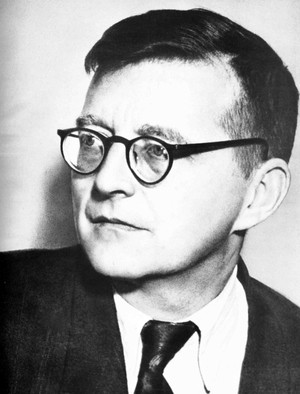Dmitry ShostakovichComposerDmitri Dmitriyevich Shostakovich (25 September 1906 – 9 August 1975) was a Soviet Russian composer and pianist and a prominent figure of 20th century music. Shostakovich achieved fame in the Soviet Union under the patronage of Leon Trotsky's chief of staff Mikhail Tukhachevsky, but later had a complex and difficult relationship with the government. Nevertheless, he received accolades and state awards and served in the Supreme Soviet of the RSFSR (1947–1962) and the USSR (from 1962 until death). After a period influenced by Sergei Prokofiev and Igor Stravinsky, Shostakovich developed a hybrid style, as exemplified by Lady Macbeth of the Mtsensk District (1934). This single work juxtaposed a wide variety of trends, including the neo-classical style (showing the influence of Stravinsky) and post-Romanticism (after Gustav Mahler). Sharp contrasts and elements of the grotesque characterize much of his music. Shostakovich's orchestral works include 15 symphonies and six concerti. His chamber output includes 15 string quartets, a piano quintet, two piano trios, and two pieces for string octet. His piano works include two solo sonatas, an early set of preludes, and a later set of 24 preludes and fugues. Other works include three operas, several song cycles, ballets, and a substantial quantity of film music.
Shostakovich's works are broadly tonal and in the Romantic tradition, but with elements of atonality and chromaticism. In some of his later works (e.g., the Twelfth Quartet), he made use of tone rows. His output is dominated by his cycles of symphonies and string quartets, each numbering fifteen. The symphonies are distributed fairly evenly throughout his career, while the quartets are concentrated towards the latter part. Among the most popular are the Fifth and Seventh Symphonies and the Eighth and Fifteenth Quartets. Other works include the operas Lady Macbeth of Mtsensk, The Nose and the unfinished The Gamblers based on the comedy of Nikolai Gogol; six concertos (two each for piano, violin and cello); two piano trios; and a large quantity of film music. Shostakovich's music shows the influence of many of the composers he most admired: Bach in his fugues and passacaglias; Beethoven in the late quartets; Mahler in the symphonies and Berg in his use of musical codes and quotations. Among Russian composers, he particularly admired Modest Mussorgsky, whose operas Boris Godunov and Khovanshchina he re-orchestrated; Mussorgsky's influence is most prominent in the wintry scenes of Lady Macbeth and the Eleventh Symphony, as well as in his satirical works such as "Rayok". Prokofiev's influence is most apparent in the earlier piano works, such as the first sonata and first concerto. The influence of Russian church and folk music is very evident in his works for unaccompanied choir of the 1950s. Shostakovich's relationship with Stravinsky was profoundly ambivalent; as he wrote to Glikman, "Stravinsky the composer I worship. Stravinsky the thinker I despise." He was particularly enamoured of the Symphony of Psalms, presenting a copy of his own piano version of it to Stravinsky when the latter visited the USSR in 1962. (The meeting of the two composers was not very successful, however; observers commented on Shostakovich's extreme nervousness and Stravinsky's "cruelty" to him.) Many commentators have noted the disjunction between the experimental works before the 1936 denunciation and the more conservative ones that followed; the composer told Flora Litvinova, "without 'Party guidance' ... I would have displayed more brilliance, used more sarcasm, I could have revealed my ideas openly instead of having to resort to camouflage." Articles published by Shostakovich in 1934 and 1935 cited Berg, Schoenberg, Krenek, Hindemith, "and especially Stravinsky" among his influences. Key works of the earlier period are the First Symphony, which combined the academicism of the conservatory with his progressive inclinations; The Nose ("The most uncompromisingly modernist of all his stage-works"); Lady Macbeth. which precipitated the denunciation; and the Fourth Symphony, described in Grove's Dictionary as "a colossal synthesis of Shostakovich's musical development to date". The Fourth Symphony was also the first in which the influence of Mahler came to the fore, prefiguring the route Shostakovich was to take to secure his rehabilitation, while he himself admitted that the preceding two were his least successful. In the years after 1936, Shostakovich's symphonic works were outwardly musically conservative, regardless of any subversive political content. During this time he turned increasingly to chamber works, a field that permitted the composer to explore different and often darker ideas without inviting external scrutiny. While his chamber works were largely tonal, they gave Shostakovich an outlet for sombre reflection not welcomed in his more public works. This is most apparent in the late chamber works, which portray what is described in Grove's Dictionary as a "world of purgatorial numbness"; in some of these he included the use of tone rows, although he treated these as melodic themes rather than serially. Vocal works are also a prominent feature of his late output, setting texts often concerned with love, death and art. © wikipedia |


